Analyzing the Advantages and Disadvantages of Social Media in Business
VerifiedAdded on 2020/03/02
|14
|3415
|424
Report
AI Summary
This report provides a comprehensive analysis of the advantages and disadvantages of utilizing social networks in a business context. It begins with an introduction that highlights the significant impact of social media on modern business practices, including marketing and customer relationship management. The report then outlines the objectives and scope, followed by an extensive literature review that critically examines the concept of social networks in business, social exchange theory, the social spiral viral model, and the social staircase model. The review explores how businesses can leverage social media for increased sales, customer engagement, and brand loyalty while also addressing potential drawbacks such as negative comments and the need for ethical considerations. The report concludes with a summary, conclusion, and a list of references, offering valuable insights for businesses looking to optimize their social media strategies and navigate the complexities of the digital landscape.
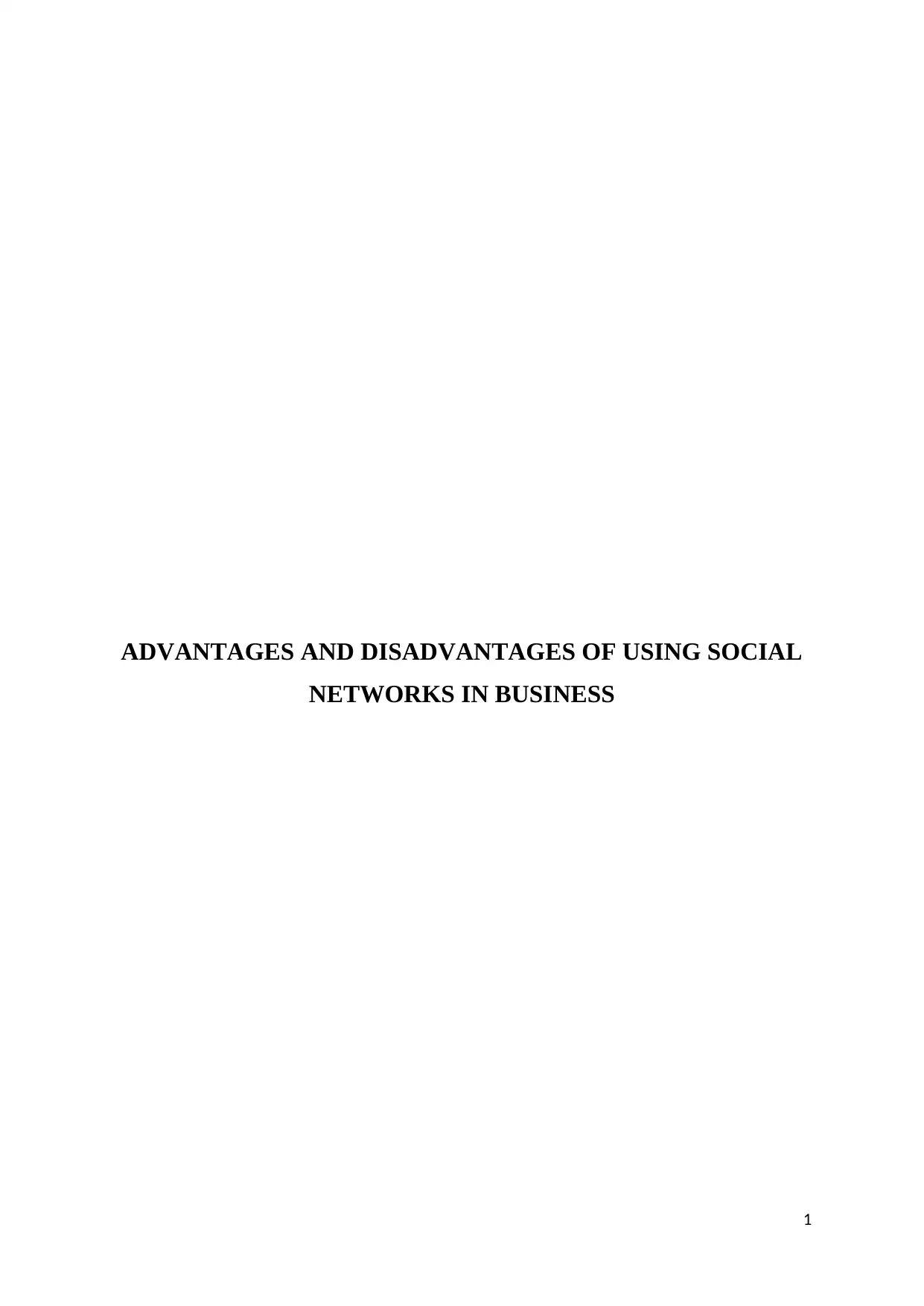
ADVANTAGES AND DISADVANTAGES OF USING SOCIAL
NETWORKS IN BUSINESS
1
NETWORKS IN BUSINESS
1
Paraphrase This Document
Need a fresh take? Get an instant paraphrase of this document with our AI Paraphraser
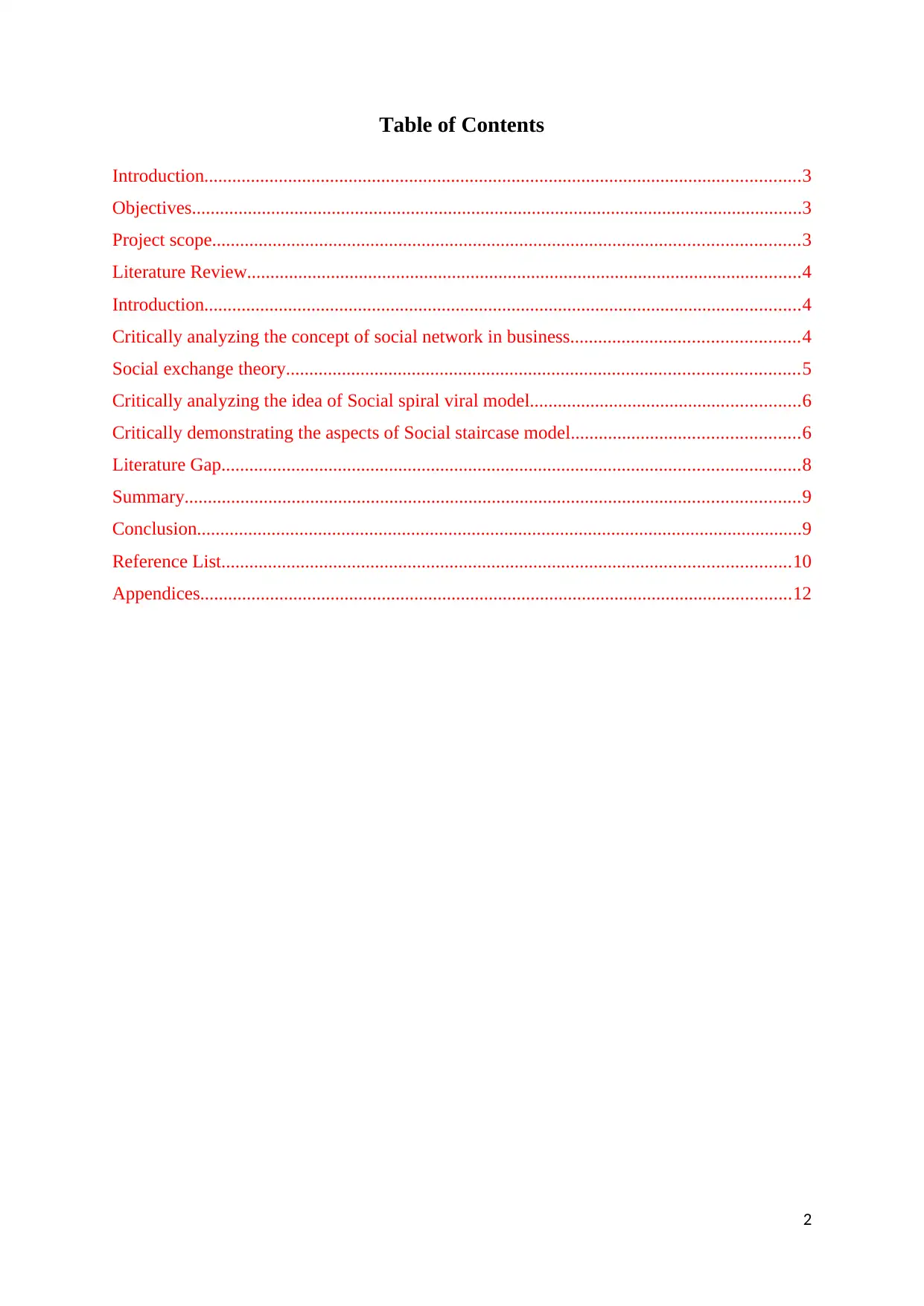
Table of Contents
Introduction................................................................................................................................3
Objectives...................................................................................................................................3
Project scope..............................................................................................................................3
Literature Review.......................................................................................................................4
Introduction................................................................................................................................4
Critically analyzing the concept of social network in business.................................................4
Social exchange theory..............................................................................................................5
Critically analyzing the idea of Social spiral viral model..........................................................6
Critically demonstrating the aspects of Social staircase model.................................................6
Literature Gap............................................................................................................................8
Summary....................................................................................................................................9
Conclusion..................................................................................................................................9
Reference List..........................................................................................................................10
Appendices...............................................................................................................................12
2
Introduction................................................................................................................................3
Objectives...................................................................................................................................3
Project scope..............................................................................................................................3
Literature Review.......................................................................................................................4
Introduction................................................................................................................................4
Critically analyzing the concept of social network in business.................................................4
Social exchange theory..............................................................................................................5
Critically analyzing the idea of Social spiral viral model..........................................................6
Critically demonstrating the aspects of Social staircase model.................................................6
Literature Gap............................................................................................................................8
Summary....................................................................................................................................9
Conclusion..................................................................................................................................9
Reference List..........................................................................................................................10
Appendices...............................................................................................................................12
2
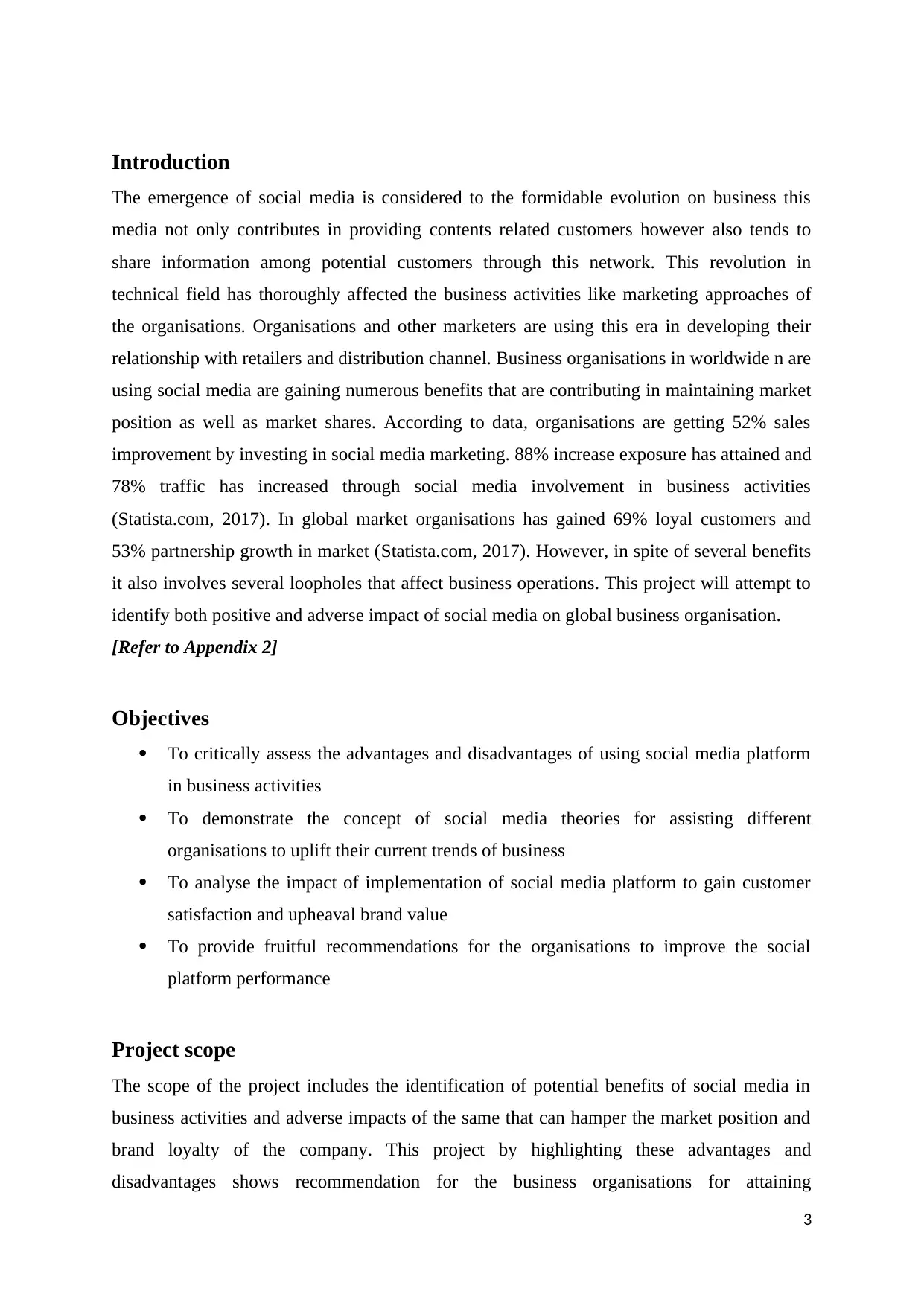
Introduction
The emergence of social media is considered to the formidable evolution on business this
media not only contributes in providing contents related customers however also tends to
share information among potential customers through this network. This revolution in
technical field has thoroughly affected the business activities like marketing approaches of
the organisations. Organisations and other marketers are using this era in developing their
relationship with retailers and distribution channel. Business organisations in worldwide n are
using social media are gaining numerous benefits that are contributing in maintaining market
position as well as market shares. According to data, organisations are getting 52% sales
improvement by investing in social media marketing. 88% increase exposure has attained and
78% traffic has increased through social media involvement in business activities
(Statista.com, 2017). In global market organisations has gained 69% loyal customers and
53% partnership growth in market (Statista.com, 2017). However, in spite of several benefits
it also involves several loopholes that affect business operations. This project will attempt to
identify both positive and adverse impact of social media on global business organisation.
[Refer to Appendix 2]
Objectives
To critically assess the advantages and disadvantages of using social media platform
in business activities
To demonstrate the concept of social media theories for assisting different
organisations to uplift their current trends of business
To analyse the impact of implementation of social media platform to gain customer
satisfaction and upheaval brand value
To provide fruitful recommendations for the organisations to improve the social
platform performance
Project scope
The scope of the project includes the identification of potential benefits of social media in
business activities and adverse impacts of the same that can hamper the market position and
brand loyalty of the company. This project by highlighting these advantages and
disadvantages shows recommendation for the business organisations for attaining
3
The emergence of social media is considered to the formidable evolution on business this
media not only contributes in providing contents related customers however also tends to
share information among potential customers through this network. This revolution in
technical field has thoroughly affected the business activities like marketing approaches of
the organisations. Organisations and other marketers are using this era in developing their
relationship with retailers and distribution channel. Business organisations in worldwide n are
using social media are gaining numerous benefits that are contributing in maintaining market
position as well as market shares. According to data, organisations are getting 52% sales
improvement by investing in social media marketing. 88% increase exposure has attained and
78% traffic has increased through social media involvement in business activities
(Statista.com, 2017). In global market organisations has gained 69% loyal customers and
53% partnership growth in market (Statista.com, 2017). However, in spite of several benefits
it also involves several loopholes that affect business operations. This project will attempt to
identify both positive and adverse impact of social media on global business organisation.
[Refer to Appendix 2]
Objectives
To critically assess the advantages and disadvantages of using social media platform
in business activities
To demonstrate the concept of social media theories for assisting different
organisations to uplift their current trends of business
To analyse the impact of implementation of social media platform to gain customer
satisfaction and upheaval brand value
To provide fruitful recommendations for the organisations to improve the social
platform performance
Project scope
The scope of the project includes the identification of potential benefits of social media in
business activities and adverse impacts of the same that can hamper the market position and
brand loyalty of the company. This project by highlighting these advantages and
disadvantages shows recommendation for the business organisations for attaining
3
⊘ This is a preview!⊘
Do you want full access?
Subscribe today to unlock all pages.

Trusted by 1+ million students worldwide
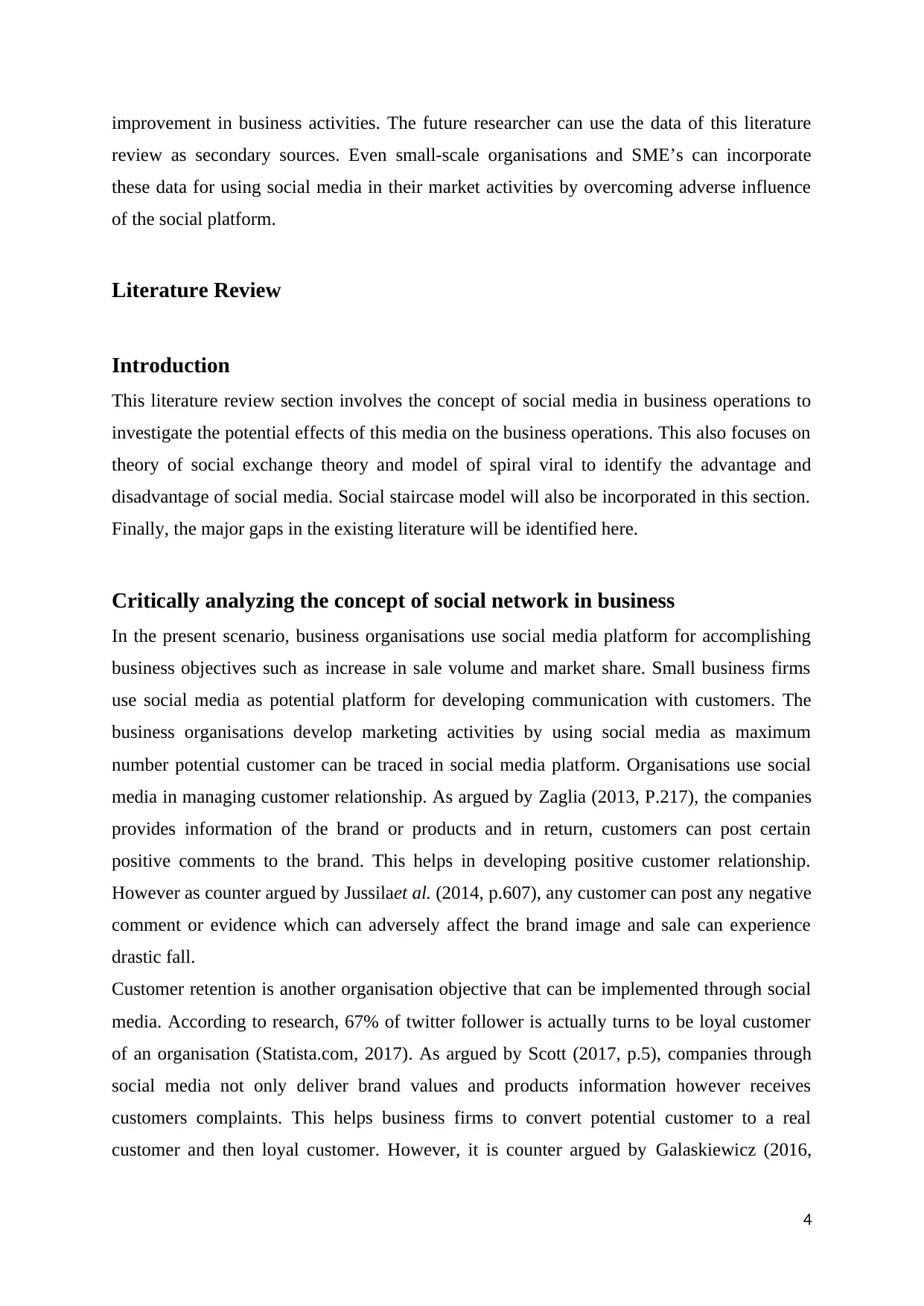
improvement in business activities. The future researcher can use the data of this literature
review as secondary sources. Even small-scale organisations and SME’s can incorporate
these data for using social media in their market activities by overcoming adverse influence
of the social platform.
Literature Review
Introduction
This literature review section involves the concept of social media in business operations to
investigate the potential effects of this media on the business operations. This also focuses on
theory of social exchange theory and model of spiral viral to identify the advantage and
disadvantage of social media. Social staircase model will also be incorporated in this section.
Finally, the major gaps in the existing literature will be identified here.
Critically analyzing the concept of social network in business
In the present scenario, business organisations use social media platform for accomplishing
business objectives such as increase in sale volume and market share. Small business firms
use social media as potential platform for developing communication with customers. The
business organisations develop marketing activities by using social media as maximum
number potential customer can be traced in social media platform. Organisations use social
media in managing customer relationship. As argued by Zaglia (2013, P.217), the companies
provides information of the brand or products and in return, customers can post certain
positive comments to the brand. This helps in developing positive customer relationship.
However as counter argued by Jussilaet al. (2014, p.607), any customer can post any negative
comment or evidence which can adversely affect the brand image and sale can experience
drastic fall.
Customer retention is another organisation objective that can be implemented through social
media. According to research, 67% of twitter follower is actually turns to be loyal customer
of an organisation (Statista.com, 2017). As argued by Scott (2017, p.5), companies through
social media not only deliver brand values and products information however receives
customers complaints. This helps business firms to convert potential customer to a real
customer and then loyal customer. However, it is counter argued by Galaskiewicz (2016,
4
review as secondary sources. Even small-scale organisations and SME’s can incorporate
these data for using social media in their market activities by overcoming adverse influence
of the social platform.
Literature Review
Introduction
This literature review section involves the concept of social media in business operations to
investigate the potential effects of this media on the business operations. This also focuses on
theory of social exchange theory and model of spiral viral to identify the advantage and
disadvantage of social media. Social staircase model will also be incorporated in this section.
Finally, the major gaps in the existing literature will be identified here.
Critically analyzing the concept of social network in business
In the present scenario, business organisations use social media platform for accomplishing
business objectives such as increase in sale volume and market share. Small business firms
use social media as potential platform for developing communication with customers. The
business organisations develop marketing activities by using social media as maximum
number potential customer can be traced in social media platform. Organisations use social
media in managing customer relationship. As argued by Zaglia (2013, P.217), the companies
provides information of the brand or products and in return, customers can post certain
positive comments to the brand. This helps in developing positive customer relationship.
However as counter argued by Jussilaet al. (2014, p.607), any customer can post any negative
comment or evidence which can adversely affect the brand image and sale can experience
drastic fall.
Customer retention is another organisation objective that can be implemented through social
media. According to research, 67% of twitter follower is actually turns to be loyal customer
of an organisation (Statista.com, 2017). As argued by Scott (2017, p.5), companies through
social media not only deliver brand values and products information however receives
customers complaints. This helps business firms to convert potential customer to a real
customer and then loyal customer. However, it is counter argued by Galaskiewicz (2016,
4
Paraphrase This Document
Need a fresh take? Get an instant paraphrase of this document with our AI Paraphraser
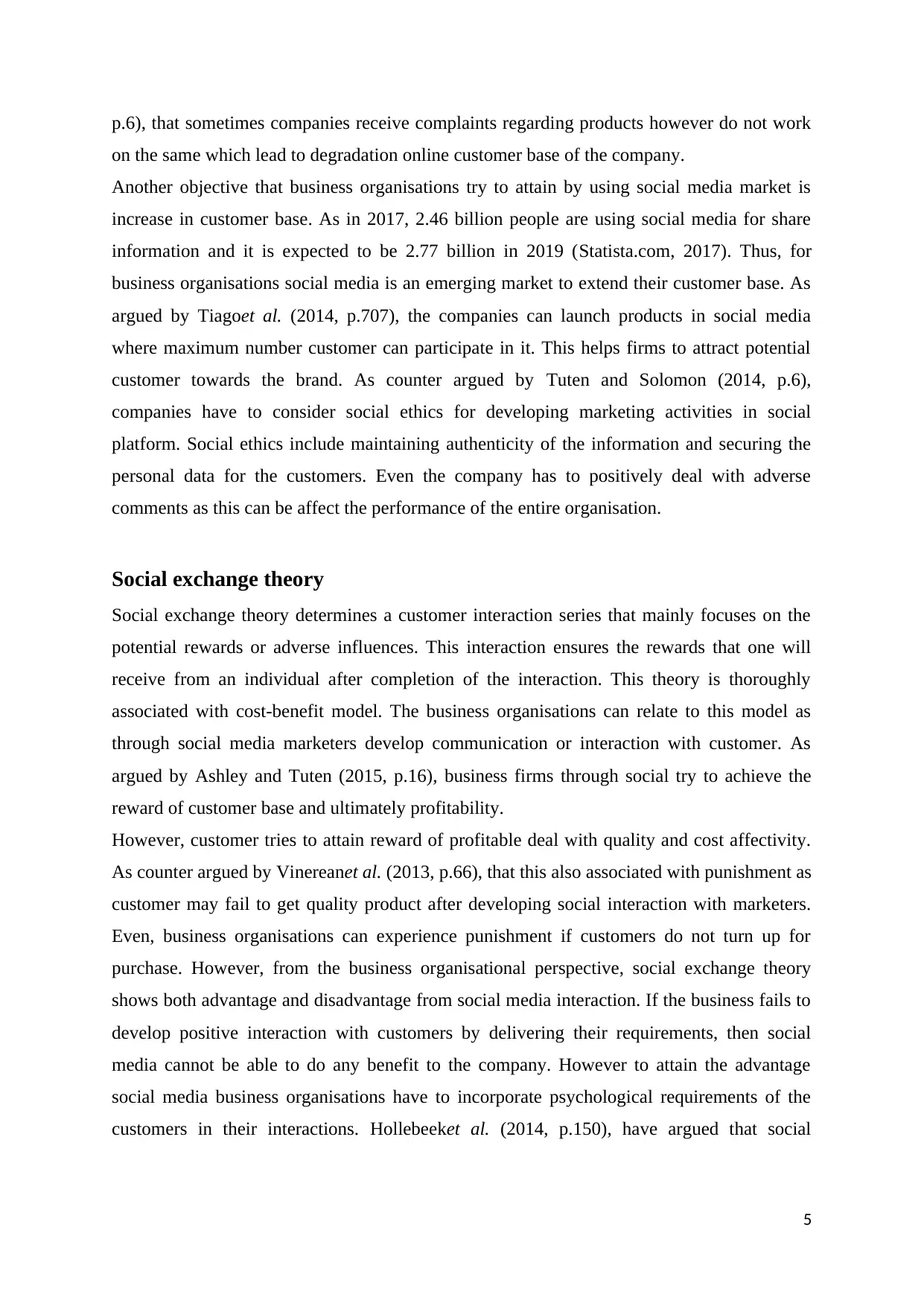
p.6), that sometimes companies receive complaints regarding products however do not work
on the same which lead to degradation online customer base of the company.
Another objective that business organisations try to attain by using social media market is
increase in customer base. As in 2017, 2.46 billion people are using social media for share
information and it is expected to be 2.77 billion in 2019 (Statista.com, 2017). Thus, for
business organisations social media is an emerging market to extend their customer base. As
argued by Tiagoet al. (2014, p.707), the companies can launch products in social media
where maximum number customer can participate in it. This helps firms to attract potential
customer towards the brand. As counter argued by Tuten and Solomon (2014, p.6),
companies have to consider social ethics for developing marketing activities in social
platform. Social ethics include maintaining authenticity of the information and securing the
personal data for the customers. Even the company has to positively deal with adverse
comments as this can be affect the performance of the entire organisation.
Social exchange theory
Social exchange theory determines a customer interaction series that mainly focuses on the
potential rewards or adverse influences. This interaction ensures the rewards that one will
receive from an individual after completion of the interaction. This theory is thoroughly
associated with cost-benefit model. The business organisations can relate to this model as
through social media marketers develop communication or interaction with customer. As
argued by Ashley and Tuten (2015, p.16), business firms through social try to achieve the
reward of customer base and ultimately profitability.
However, customer tries to attain reward of profitable deal with quality and cost affectivity.
As counter argued by Vinereanet al. (2013, p.66), that this also associated with punishment as
customer may fail to get quality product after developing social interaction with marketers.
Even, business organisations can experience punishment if customers do not turn up for
purchase. However, from the business organisational perspective, social exchange theory
shows both advantage and disadvantage from social media interaction. If the business fails to
develop positive interaction with customers by delivering their requirements, then social
media cannot be able to do any benefit to the company. However to attain the advantage
social media business organisations have to incorporate psychological requirements of the
customers in their interactions. Hollebeeket al. (2014, p.150), have argued that social
5
on the same which lead to degradation online customer base of the company.
Another objective that business organisations try to attain by using social media market is
increase in customer base. As in 2017, 2.46 billion people are using social media for share
information and it is expected to be 2.77 billion in 2019 (Statista.com, 2017). Thus, for
business organisations social media is an emerging market to extend their customer base. As
argued by Tiagoet al. (2014, p.707), the companies can launch products in social media
where maximum number customer can participate in it. This helps firms to attract potential
customer towards the brand. As counter argued by Tuten and Solomon (2014, p.6),
companies have to consider social ethics for developing marketing activities in social
platform. Social ethics include maintaining authenticity of the information and securing the
personal data for the customers. Even the company has to positively deal with adverse
comments as this can be affect the performance of the entire organisation.
Social exchange theory
Social exchange theory determines a customer interaction series that mainly focuses on the
potential rewards or adverse influences. This interaction ensures the rewards that one will
receive from an individual after completion of the interaction. This theory is thoroughly
associated with cost-benefit model. The business organisations can relate to this model as
through social media marketers develop communication or interaction with customer. As
argued by Ashley and Tuten (2015, p.16), business firms through social try to achieve the
reward of customer base and ultimately profitability.
However, customer tries to attain reward of profitable deal with quality and cost affectivity.
As counter argued by Vinereanet al. (2013, p.66), that this also associated with punishment as
customer may fail to get quality product after developing social interaction with marketers.
Even, business organisations can experience punishment if customers do not turn up for
purchase. However, from the business organisational perspective, social exchange theory
shows both advantage and disadvantage from social media interaction. If the business fails to
develop positive interaction with customers by delivering their requirements, then social
media cannot be able to do any benefit to the company. However to attain the advantage
social media business organisations have to incorporate psychological requirements of the
customers in their interactions. Hollebeeket al. (2014, p.150), have argued that social
5
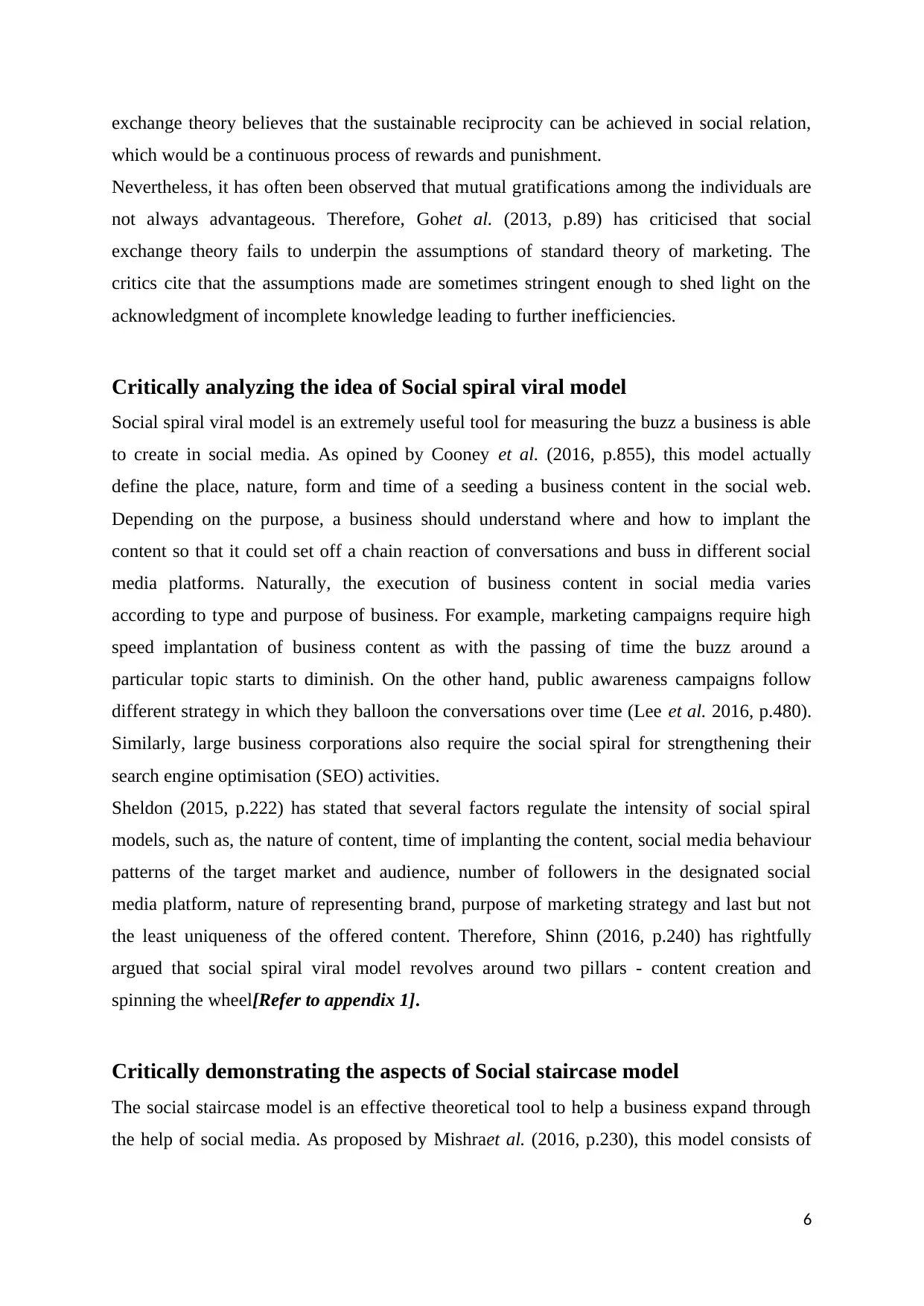
exchange theory believes that the sustainable reciprocity can be achieved in social relation,
which would be a continuous process of rewards and punishment.
Nevertheless, it has often been observed that mutual gratifications among the individuals are
not always advantageous. Therefore, Gohet al. (2013, p.89) has criticised that social
exchange theory fails to underpin the assumptions of standard theory of marketing. The
critics cite that the assumptions made are sometimes stringent enough to shed light on the
acknowledgment of incomplete knowledge leading to further inefficiencies.
Critically analyzing the idea of Social spiral viral model
Social spiral viral model is an extremely useful tool for measuring the buzz a business is able
to create in social media. As opined by Cooney et al. (2016, p.855), this model actually
define the place, nature, form and time of a seeding a business content in the social web.
Depending on the purpose, a business should understand where and how to implant the
content so that it could set off a chain reaction of conversations and buss in different social
media platforms. Naturally, the execution of business content in social media varies
according to type and purpose of business. For example, marketing campaigns require high
speed implantation of business content as with the passing of time the buzz around a
particular topic starts to diminish. On the other hand, public awareness campaigns follow
different strategy in which they balloon the conversations over time (Lee et al. 2016, p.480).
Similarly, large business corporations also require the social spiral for strengthening their
search engine optimisation (SEO) activities.
Sheldon (2015, p.222) has stated that several factors regulate the intensity of social spiral
models, such as, the nature of content, time of implanting the content, social media behaviour
patterns of the target market and audience, number of followers in the designated social
media platform, nature of representing brand, purpose of marketing strategy and last but not
the least uniqueness of the offered content. Therefore, Shinn (2016, p.240) has rightfully
argued that social spiral viral model revolves around two pillars - content creation and
spinning the wheel[Refer to appendix 1].
Critically demonstrating the aspects of Social staircase model
The social staircase model is an effective theoretical tool to help a business expand through
the help of social media. As proposed by Mishraet al. (2016, p.230), this model consists of
6
which would be a continuous process of rewards and punishment.
Nevertheless, it has often been observed that mutual gratifications among the individuals are
not always advantageous. Therefore, Gohet al. (2013, p.89) has criticised that social
exchange theory fails to underpin the assumptions of standard theory of marketing. The
critics cite that the assumptions made are sometimes stringent enough to shed light on the
acknowledgment of incomplete knowledge leading to further inefficiencies.
Critically analyzing the idea of Social spiral viral model
Social spiral viral model is an extremely useful tool for measuring the buzz a business is able
to create in social media. As opined by Cooney et al. (2016, p.855), this model actually
define the place, nature, form and time of a seeding a business content in the social web.
Depending on the purpose, a business should understand where and how to implant the
content so that it could set off a chain reaction of conversations and buss in different social
media platforms. Naturally, the execution of business content in social media varies
according to type and purpose of business. For example, marketing campaigns require high
speed implantation of business content as with the passing of time the buzz around a
particular topic starts to diminish. On the other hand, public awareness campaigns follow
different strategy in which they balloon the conversations over time (Lee et al. 2016, p.480).
Similarly, large business corporations also require the social spiral for strengthening their
search engine optimisation (SEO) activities.
Sheldon (2015, p.222) has stated that several factors regulate the intensity of social spiral
models, such as, the nature of content, time of implanting the content, social media behaviour
patterns of the target market and audience, number of followers in the designated social
media platform, nature of representing brand, purpose of marketing strategy and last but not
the least uniqueness of the offered content. Therefore, Shinn (2016, p.240) has rightfully
argued that social spiral viral model revolves around two pillars - content creation and
spinning the wheel[Refer to appendix 1].
Critically demonstrating the aspects of Social staircase model
The social staircase model is an effective theoretical tool to help a business expand through
the help of social media. As proposed by Mishraet al. (2016, p.230), this model consists of
6
⊘ This is a preview!⊘
Do you want full access?
Subscribe today to unlock all pages.

Trusted by 1+ million students worldwide
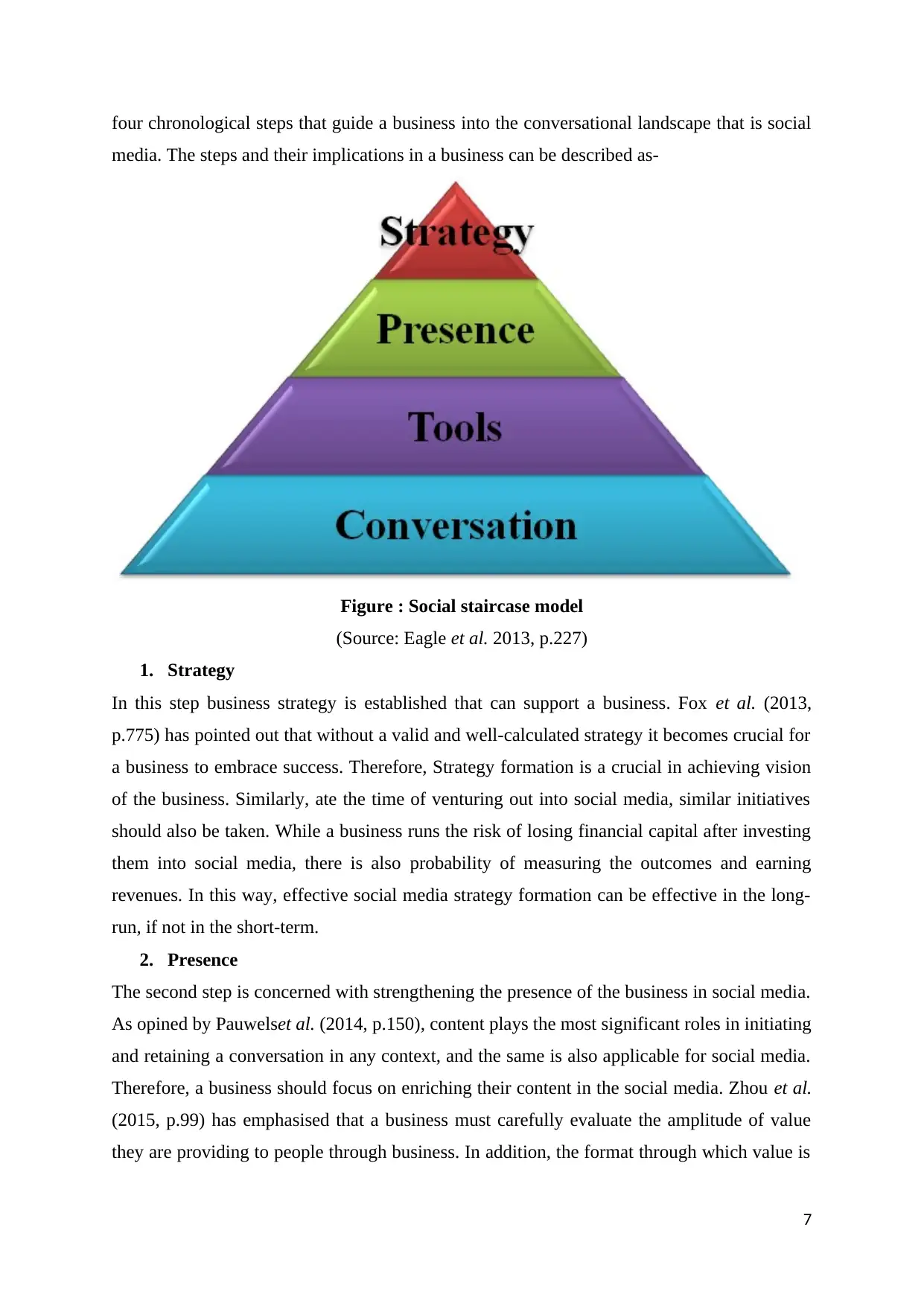
four chronological steps that guide a business into the conversational landscape that is social
media. The steps and their implications in a business can be described as-
Figure : Social staircase model
(Source: Eagle et al. 2013, p.227)
1. Strategy
In this step business strategy is established that can support a business. Fox et al. (2013,
p.775) has pointed out that without a valid and well-calculated strategy it becomes crucial for
a business to embrace success. Therefore, Strategy formation is a crucial in achieving vision
of the business. Similarly, ate the time of venturing out into social media, similar initiatives
should also be taken. While a business runs the risk of losing financial capital after investing
them into social media, there is also probability of measuring the outcomes and earning
revenues. In this way, effective social media strategy formation can be effective in the long-
run, if not in the short-term.
2. Presence
The second step is concerned with strengthening the presence of the business in social media.
As opined by Pauwelset al. (2014, p.150), content plays the most significant roles in initiating
and retaining a conversation in any context, and the same is also applicable for social media.
Therefore, a business should focus on enriching their content in the social media. Zhou et al.
(2015, p.99) has emphasised that a business must carefully evaluate the amplitude of value
they are providing to people through business. In addition, the format through which value is
7
media. The steps and their implications in a business can be described as-
Figure : Social staircase model
(Source: Eagle et al. 2013, p.227)
1. Strategy
In this step business strategy is established that can support a business. Fox et al. (2013,
p.775) has pointed out that without a valid and well-calculated strategy it becomes crucial for
a business to embrace success. Therefore, Strategy formation is a crucial in achieving vision
of the business. Similarly, ate the time of venturing out into social media, similar initiatives
should also be taken. While a business runs the risk of losing financial capital after investing
them into social media, there is also probability of measuring the outcomes and earning
revenues. In this way, effective social media strategy formation can be effective in the long-
run, if not in the short-term.
2. Presence
The second step is concerned with strengthening the presence of the business in social media.
As opined by Pauwelset al. (2014, p.150), content plays the most significant roles in initiating
and retaining a conversation in any context, and the same is also applicable for social media.
Therefore, a business should focus on enriching their content in the social media. Zhou et al.
(2015, p.99) has emphasised that a business must carefully evaluate the amplitude of value
they are providing to people through business. In addition, the format through which value is
7
Paraphrase This Document
Need a fresh take? Get an instant paraphrase of this document with our AI Paraphraser
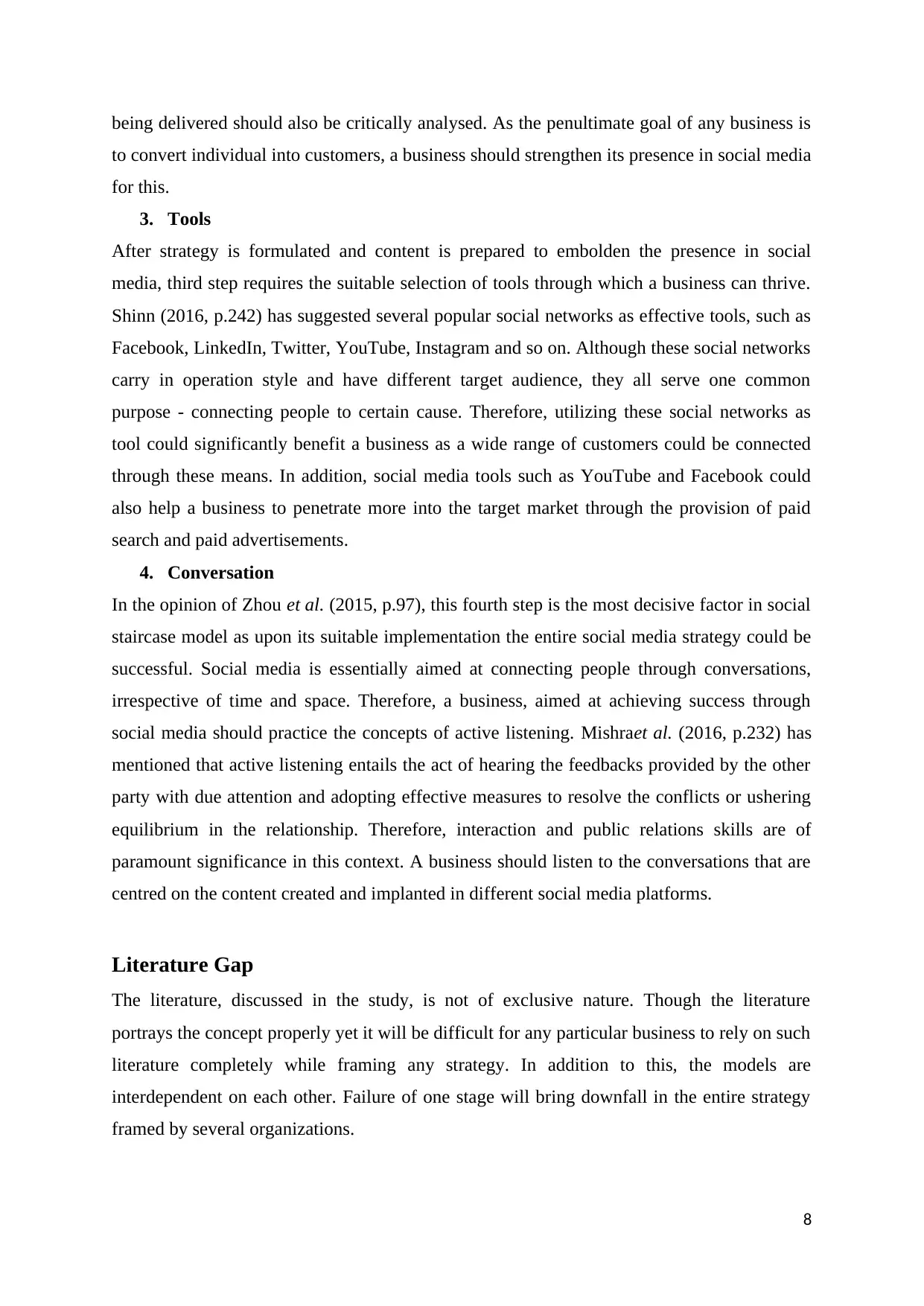
being delivered should also be critically analysed. As the penultimate goal of any business is
to convert individual into customers, a business should strengthen its presence in social media
for this.
3. Tools
After strategy is formulated and content is prepared to embolden the presence in social
media, third step requires the suitable selection of tools through which a business can thrive.
Shinn (2016, p.242) has suggested several popular social networks as effective tools, such as
Facebook, LinkedIn, Twitter, YouTube, Instagram and so on. Although these social networks
carry in operation style and have different target audience, they all serve one common
purpose - connecting people to certain cause. Therefore, utilizing these social networks as
tool could significantly benefit a business as a wide range of customers could be connected
through these means. In addition, social media tools such as YouTube and Facebook could
also help a business to penetrate more into the target market through the provision of paid
search and paid advertisements.
4. Conversation
In the opinion of Zhou et al. (2015, p.97), this fourth step is the most decisive factor in social
staircase model as upon its suitable implementation the entire social media strategy could be
successful. Social media is essentially aimed at connecting people through conversations,
irrespective of time and space. Therefore, a business, aimed at achieving success through
social media should practice the concepts of active listening. Mishraet al. (2016, p.232) has
mentioned that active listening entails the act of hearing the feedbacks provided by the other
party with due attention and adopting effective measures to resolve the conflicts or ushering
equilibrium in the relationship. Therefore, interaction and public relations skills are of
paramount significance in this context. A business should listen to the conversations that are
centred on the content created and implanted in different social media platforms.
Literature Gap
The literature, discussed in the study, is not of exclusive nature. Though the literature
portrays the concept properly yet it will be difficult for any particular business to rely on such
literature completely while framing any strategy. In addition to this, the models are
interdependent on each other. Failure of one stage will bring downfall in the entire strategy
framed by several organizations.
8
to convert individual into customers, a business should strengthen its presence in social media
for this.
3. Tools
After strategy is formulated and content is prepared to embolden the presence in social
media, third step requires the suitable selection of tools through which a business can thrive.
Shinn (2016, p.242) has suggested several popular social networks as effective tools, such as
Facebook, LinkedIn, Twitter, YouTube, Instagram and so on. Although these social networks
carry in operation style and have different target audience, they all serve one common
purpose - connecting people to certain cause. Therefore, utilizing these social networks as
tool could significantly benefit a business as a wide range of customers could be connected
through these means. In addition, social media tools such as YouTube and Facebook could
also help a business to penetrate more into the target market through the provision of paid
search and paid advertisements.
4. Conversation
In the opinion of Zhou et al. (2015, p.97), this fourth step is the most decisive factor in social
staircase model as upon its suitable implementation the entire social media strategy could be
successful. Social media is essentially aimed at connecting people through conversations,
irrespective of time and space. Therefore, a business, aimed at achieving success through
social media should practice the concepts of active listening. Mishraet al. (2016, p.232) has
mentioned that active listening entails the act of hearing the feedbacks provided by the other
party with due attention and adopting effective measures to resolve the conflicts or ushering
equilibrium in the relationship. Therefore, interaction and public relations skills are of
paramount significance in this context. A business should listen to the conversations that are
centred on the content created and implanted in different social media platforms.
Literature Gap
The literature, discussed in the study, is not of exclusive nature. Though the literature
portrays the concept properly yet it will be difficult for any particular business to rely on such
literature completely while framing any strategy. In addition to this, the models are
interdependent on each other. Failure of one stage will bring downfall in the entire strategy
framed by several organizations.
8
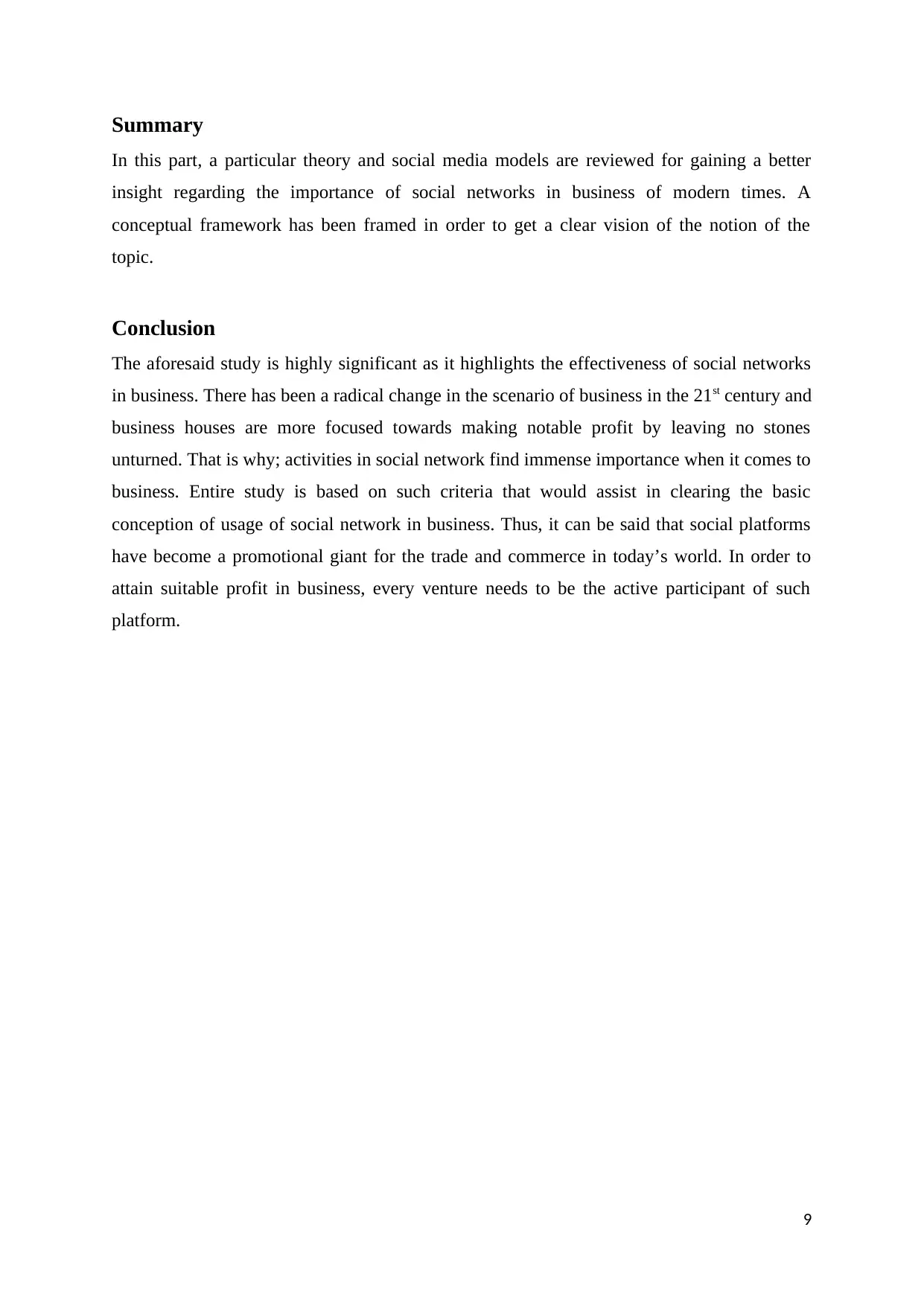
Summary
In this part, a particular theory and social media models are reviewed for gaining a better
insight regarding the importance of social networks in business of modern times. A
conceptual framework has been framed in order to get a clear vision of the notion of the
topic.
Conclusion
The aforesaid study is highly significant as it highlights the effectiveness of social networks
in business. There has been a radical change in the scenario of business in the 21st century and
business houses are more focused towards making notable profit by leaving no stones
unturned. That is why; activities in social network find immense importance when it comes to
business. Entire study is based on such criteria that would assist in clearing the basic
conception of usage of social network in business. Thus, it can be said that social platforms
have become a promotional giant for the trade and commerce in today’s world. In order to
attain suitable profit in business, every venture needs to be the active participant of such
platform.
9
In this part, a particular theory and social media models are reviewed for gaining a better
insight regarding the importance of social networks in business of modern times. A
conceptual framework has been framed in order to get a clear vision of the notion of the
topic.
Conclusion
The aforesaid study is highly significant as it highlights the effectiveness of social networks
in business. There has been a radical change in the scenario of business in the 21st century and
business houses are more focused towards making notable profit by leaving no stones
unturned. That is why; activities in social network find immense importance when it comes to
business. Entire study is based on such criteria that would assist in clearing the basic
conception of usage of social network in business. Thus, it can be said that social platforms
have become a promotional giant for the trade and commerce in today’s world. In order to
attain suitable profit in business, every venture needs to be the active participant of such
platform.
9
⊘ This is a preview!⊘
Do you want full access?
Subscribe today to unlock all pages.

Trusted by 1+ million students worldwide
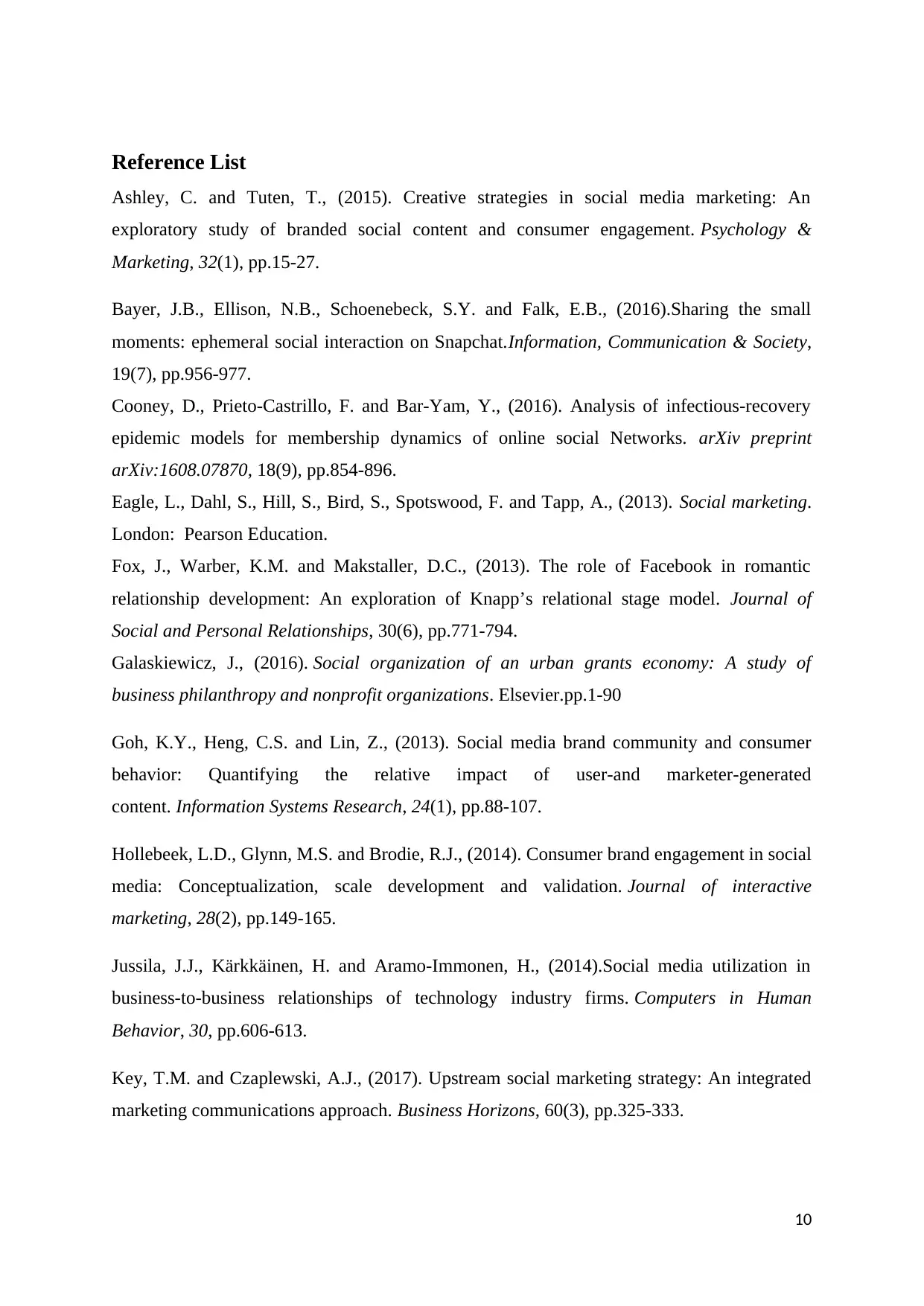
Reference List
Ashley, C. and Tuten, T., (2015). Creative strategies in social media marketing: An
exploratory study of branded social content and consumer engagement. Psychology &
Marketing, 32(1), pp.15-27.
Bayer, J.B., Ellison, N.B., Schoenebeck, S.Y. and Falk, E.B., (2016).Sharing the small
moments: ephemeral social interaction on Snapchat.Information, Communication & Society,
19(7), pp.956-977.
Cooney, D., Prieto-Castrillo, F. and Bar-Yam, Y., (2016). Analysis of infectious-recovery
epidemic models for membership dynamics of online social Networks. arXiv preprint
arXiv:1608.07870, 18(9), pp.854-896.
Eagle, L., Dahl, S., Hill, S., Bird, S., Spotswood, F. and Tapp, A., (2013). Social marketing.
London: Pearson Education.
Fox, J., Warber, K.M. and Makstaller, D.C., (2013). The role of Facebook in romantic
relationship development: An exploration of Knapp’s relational stage model. Journal of
Social and Personal Relationships, 30(6), pp.771-794.
Galaskiewicz, J., (2016). Social organization of an urban grants economy: A study of
business philanthropy and nonprofit organizations. Elsevier.pp.1-90
Goh, K.Y., Heng, C.S. and Lin, Z., (2013). Social media brand community and consumer
behavior: Quantifying the relative impact of user-and marketer-generated
content. Information Systems Research, 24(1), pp.88-107.
Hollebeek, L.D., Glynn, M.S. and Brodie, R.J., (2014). Consumer brand engagement in social
media: Conceptualization, scale development and validation. Journal of interactive
marketing, 28(2), pp.149-165.
Jussila, J.J., Kärkkäinen, H. and Aramo-Immonen, H., (2014).Social media utilization in
business-to-business relationships of technology industry firms. Computers in Human
Behavior, 30, pp.606-613.
Key, T.M. and Czaplewski, A.J., (2017). Upstream social marketing strategy: An integrated
marketing communications approach. Business Horizons, 60(3), pp.325-333.
10
Ashley, C. and Tuten, T., (2015). Creative strategies in social media marketing: An
exploratory study of branded social content and consumer engagement. Psychology &
Marketing, 32(1), pp.15-27.
Bayer, J.B., Ellison, N.B., Schoenebeck, S.Y. and Falk, E.B., (2016).Sharing the small
moments: ephemeral social interaction on Snapchat.Information, Communication & Society,
19(7), pp.956-977.
Cooney, D., Prieto-Castrillo, F. and Bar-Yam, Y., (2016). Analysis of infectious-recovery
epidemic models for membership dynamics of online social Networks. arXiv preprint
arXiv:1608.07870, 18(9), pp.854-896.
Eagle, L., Dahl, S., Hill, S., Bird, S., Spotswood, F. and Tapp, A., (2013). Social marketing.
London: Pearson Education.
Fox, J., Warber, K.M. and Makstaller, D.C., (2013). The role of Facebook in romantic
relationship development: An exploration of Knapp’s relational stage model. Journal of
Social and Personal Relationships, 30(6), pp.771-794.
Galaskiewicz, J., (2016). Social organization of an urban grants economy: A study of
business philanthropy and nonprofit organizations. Elsevier.pp.1-90
Goh, K.Y., Heng, C.S. and Lin, Z., (2013). Social media brand community and consumer
behavior: Quantifying the relative impact of user-and marketer-generated
content. Information Systems Research, 24(1), pp.88-107.
Hollebeek, L.D., Glynn, M.S. and Brodie, R.J., (2014). Consumer brand engagement in social
media: Conceptualization, scale development and validation. Journal of interactive
marketing, 28(2), pp.149-165.
Jussila, J.J., Kärkkäinen, H. and Aramo-Immonen, H., (2014).Social media utilization in
business-to-business relationships of technology industry firms. Computers in Human
Behavior, 30, pp.606-613.
Key, T.M. and Czaplewski, A.J., (2017). Upstream social marketing strategy: An integrated
marketing communications approach. Business Horizons, 60(3), pp.325-333.
10
Paraphrase This Document
Need a fresh take? Get an instant paraphrase of this document with our AI Paraphraser
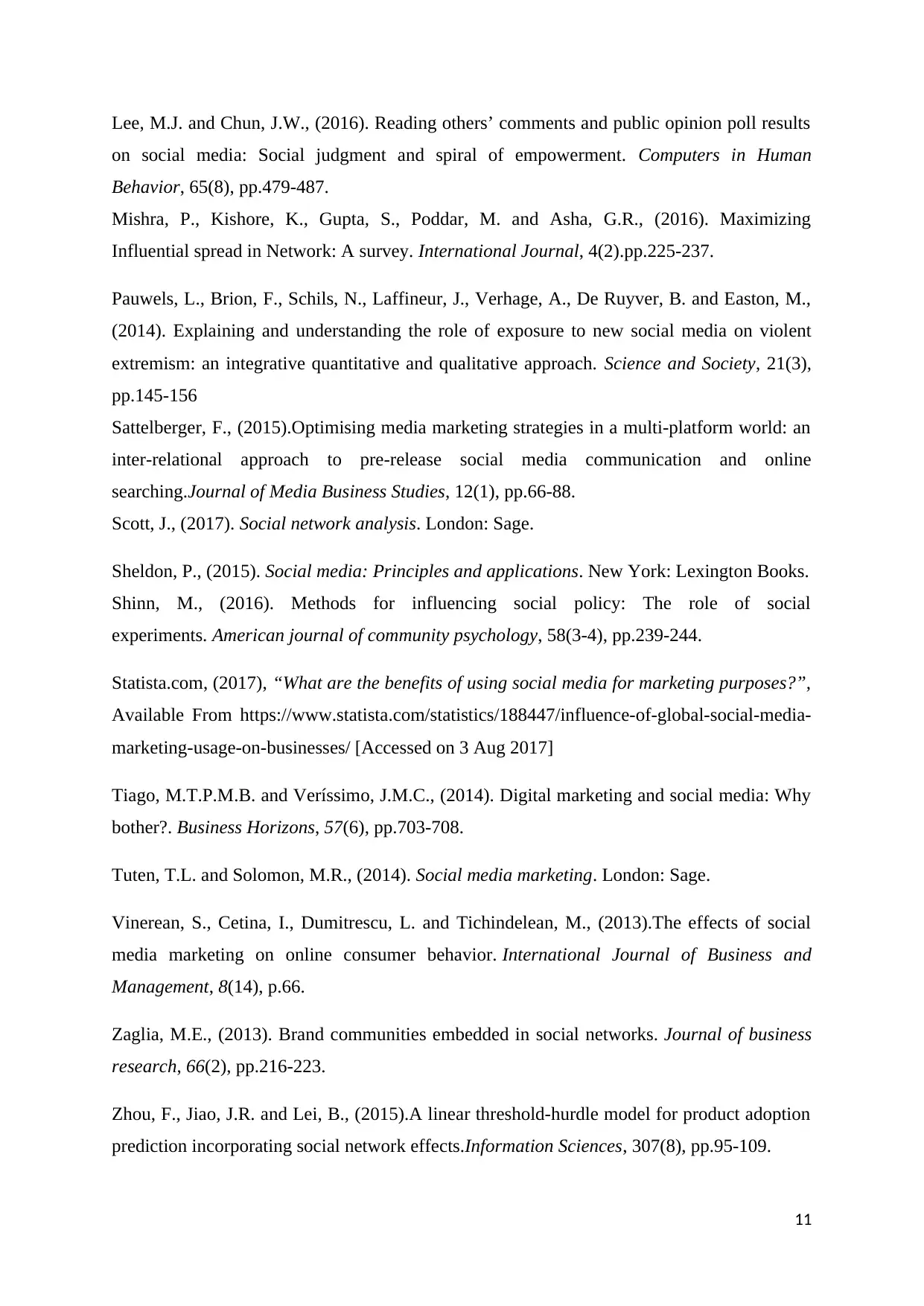
Lee, M.J. and Chun, J.W., (2016). Reading others’ comments and public opinion poll results
on social media: Social judgment and spiral of empowerment. Computers in Human
Behavior, 65(8), pp.479-487.
Mishra, P., Kishore, K., Gupta, S., Poddar, M. and Asha, G.R., (2016). Maximizing
Influential spread in Network: A survey. International Journal, 4(2).pp.225-237.
Pauwels, L., Brion, F., Schils, N., Laffineur, J., Verhage, A., De Ruyver, B. and Easton, M.,
(2014). Explaining and understanding the role of exposure to new social media on violent
extremism: an integrative quantitative and qualitative approach. Science and Society, 21(3),
pp.145-156
Sattelberger, F., (2015).Optimising media marketing strategies in a multi-platform world: an
inter-relational approach to pre-release social media communication and online
searching.Journal of Media Business Studies, 12(1), pp.66-88.
Scott, J., (2017). Social network analysis. London: Sage.
Sheldon, P., (2015). Social media: Principles and applications. New York: Lexington Books.
Shinn, M., (2016). Methods for influencing social policy: The role of social
experiments. American journal of community psychology, 58(3-4), pp.239-244.
Statista.com, (2017), “What are the benefits of using social media for marketing purposes?”,
Available From https://www.statista.com/statistics/188447/influence-of-global-social-media-
marketing-usage-on-businesses/ [Accessed on 3 Aug 2017]
Tiago, M.T.P.M.B. and Veríssimo, J.M.C., (2014). Digital marketing and social media: Why
bother?. Business Horizons, 57(6), pp.703-708.
Tuten, T.L. and Solomon, M.R., (2014). Social media marketing. London: Sage.
Vinerean, S., Cetina, I., Dumitrescu, L. and Tichindelean, M., (2013).The effects of social
media marketing on online consumer behavior. International Journal of Business and
Management, 8(14), p.66.
Zaglia, M.E., (2013). Brand communities embedded in social networks. Journal of business
research, 66(2), pp.216-223.
Zhou, F., Jiao, J.R. and Lei, B., (2015).A linear threshold-hurdle model for product adoption
prediction incorporating social network effects.Information Sciences, 307(8), pp.95-109.
11
on social media: Social judgment and spiral of empowerment. Computers in Human
Behavior, 65(8), pp.479-487.
Mishra, P., Kishore, K., Gupta, S., Poddar, M. and Asha, G.R., (2016). Maximizing
Influential spread in Network: A survey. International Journal, 4(2).pp.225-237.
Pauwels, L., Brion, F., Schils, N., Laffineur, J., Verhage, A., De Ruyver, B. and Easton, M.,
(2014). Explaining and understanding the role of exposure to new social media on violent
extremism: an integrative quantitative and qualitative approach. Science and Society, 21(3),
pp.145-156
Sattelberger, F., (2015).Optimising media marketing strategies in a multi-platform world: an
inter-relational approach to pre-release social media communication and online
searching.Journal of Media Business Studies, 12(1), pp.66-88.
Scott, J., (2017). Social network analysis. London: Sage.
Sheldon, P., (2015). Social media: Principles and applications. New York: Lexington Books.
Shinn, M., (2016). Methods for influencing social policy: The role of social
experiments. American journal of community psychology, 58(3-4), pp.239-244.
Statista.com, (2017), “What are the benefits of using social media for marketing purposes?”,
Available From https://www.statista.com/statistics/188447/influence-of-global-social-media-
marketing-usage-on-businesses/ [Accessed on 3 Aug 2017]
Tiago, M.T.P.M.B. and Veríssimo, J.M.C., (2014). Digital marketing and social media: Why
bother?. Business Horizons, 57(6), pp.703-708.
Tuten, T.L. and Solomon, M.R., (2014). Social media marketing. London: Sage.
Vinerean, S., Cetina, I., Dumitrescu, L. and Tichindelean, M., (2013).The effects of social
media marketing on online consumer behavior. International Journal of Business and
Management, 8(14), p.66.
Zaglia, M.E., (2013). Brand communities embedded in social networks. Journal of business
research, 66(2), pp.216-223.
Zhou, F., Jiao, J.R. and Lei, B., (2015).A linear threshold-hurdle model for product adoption
prediction incorporating social network effects.Information Sciences, 307(8), pp.95-109.
11

12
⊘ This is a preview!⊘
Do you want full access?
Subscribe today to unlock all pages.

Trusted by 1+ million students worldwide
1 out of 14
Related Documents
Your All-in-One AI-Powered Toolkit for Academic Success.
+13062052269
info@desklib.com
Available 24*7 on WhatsApp / Email
![[object Object]](/_next/static/media/star-bottom.7253800d.svg)
Unlock your academic potential
Copyright © 2020–2025 A2Z Services. All Rights Reserved. Developed and managed by ZUCOL.




